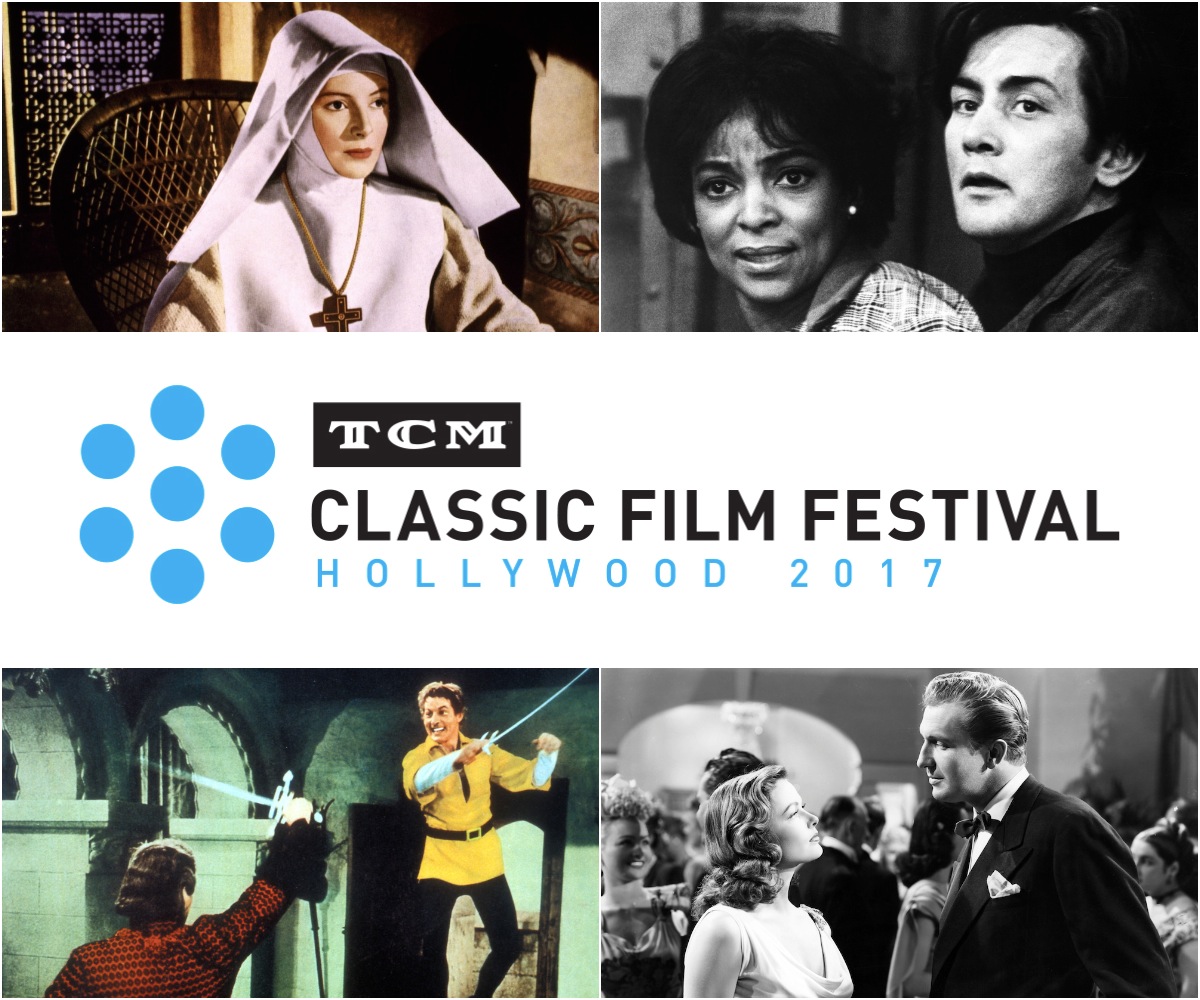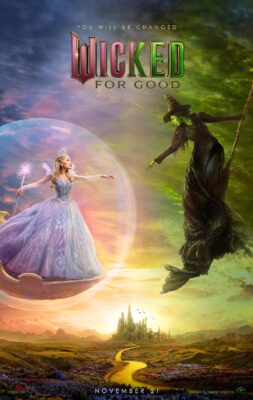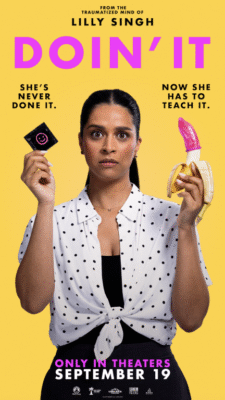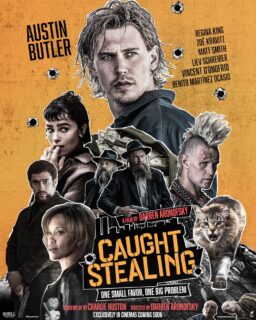Though the official theme of the eighth annual TCM Classic Film Festival was “Make ‘Em Laugh: Comedy in the Movies,” it could have been subtitled “Nitrate and Old Favorites.”
Many of the more than 100 films and events at the four-day festival, held April 6-9 at the historic TCL Chinese Theatre complex, Egyptian Theatre, Roosevelt Hotel and the Cinerama Dome, revolved around laughter—“from lowbrow to high, from slapstick to sophisticated comedies of manners,” with classics such as the silent “Speedy” (1928) to “Arsenic and Old Lace” (1944) to the more recent “Best in Show” (2000).
For many festivalgoers, however, the biggest attraction this year was the chance to view four rarely screened nitrate prints: Alfred Hitchcock’s “The Man Who Knew Too Much” (1934), Otto Preminger’s “Laura” (1944), Michael Powell/Emeric Pressburger’s “Black Narcissus” (1947) and Mitchell Leisen’s “Lady in the Dark” (1944). All were shown at the newly renovated Egyptian Theatre, built in 1922 by Hollywood impresario Sid Grauman. The renovation included a retrofitting of the theater’s projection booth to allow the screening of highly flammable nitrate film.
“We’ve wanted to do nitrate projection from Day 1 of the festival, but we’re now just getting the opportunity,” said Genevieve McGillicuddy, vice president for brand activations/partnerships at TCM and the festival’s director. “Nitrate projection is happening again, thanks in part to filmmaker Alexander Payne, who wanted to be able to project nitrate films again.”
Amid the movie merriment came moments of sadness and reflection, as festivalgoers and TCM staffers honored the legacy of longtime TCM host Robert Osborne, who died March 6 at age 84 after a long illness. In addition to a special session titled “Remembering Robert” (see related story), many festival guests shared memories of Osborne or requested moments of silence ahead of the films they introduced.
Along with the chance to watch classics on the big screen, “as they were meant to be seen,” festivalgoers soaked up the presence of Hollywood royalty. Among the filmmakers and actors appearing for special tributes were Peter Bogdanovich, Michael Douglas, Lee Grant, and Carl and Rob Reiner. Carrie Fisher and Debbie Reynolds, who died within hours of each other in December, received a posthumous salute.
But there was much more. Appearing to introduce films were James L. Brooks, Mel Brooks, Beau Bridges, Dick Cavett, Illeana Douglas, Keir Dullea, Buck Henry, Norman Jewison, Quincy Jones, John Landis, Walter Mirisch, Sidney Poitier, Martin Sheen, Alex Trebek, Fred Willard, and the ZAZ team of Jim Abrahams and David & Jerry Zucker.
Martin Scorsese, arguably America’s most preeminent living director, made a last-minute appearance to introduce the first nitrate film at TCMFF, “The Man Who Knew Too Much.” Entering to a prolonged standing ovation, he reminded the sold-out audience at the Egyptian that nitrate was phased out in the early ’50s “due to its instability—and its propensity to blow up.”
When safety film was introduced, nitrate stock fell out of use. With the move to digital projection, few U.S. theaters have the capability of screening nitrate prints. “The retrofitting of the Egyptian booth to project nitrate is a tremendous undertaking,” he said. The project was funded by TCM, the Hollywood Foreign Press Association, the American Cinematheque (the non-profit that operates the Egyptian), the Academy Film Archive and Scorsese’s own Film Foundation.
Prized for its high silver content, nitrate film dates to the earliest days of cinema. “We’re lucky to have some nitrate prints still available; some are nearly 100 years old and extremely fragile,” Scorsese said. “The beauty of nitrate is quite particular. With its rich black and gray tones, “nitrate has a kind of luminosity that other film stocks can’t duplicate,” he said. “When you’re watching a nitrate print, you can feel a direct link with the past.”
Scorsese recalled viewing a nitrate print of “Black Narcissus” in his youth. “It was like 3-D,” he said. “It was a revelation, as if something had been embossed on the screen.” He also lauded “Laura,” calling it “one of the most haunting uses of black and white ever.” As he ended his introduction, he paid homage to the human face of TCM: “What better way to celebrate Robert Osborne than with screenings of nitrate films, in the way they were meant to be seen.”
His remarks echoed those of Randy Haberkamp, managing director of preservation and foundation programs for the Academy of Motion Picture Arts and Sciences, who spoke at a press conference a day before the festival began. “If you want to understand what black and white film meant in nitrate, see ‘Laura.’ Seeing ‘Laura’ or ‘Black Narcissus’ means you’re seeing the filmmakers’ original vision,” Haberkamp said. “The goal of projecting nitrate film is to preserve as close to the original intent as possible.”
With five or six simultaneous offerings at any moment, the festival functions as an annual endurance test to see how long moviegoers “can survive on water and popcorn.” During her stage comments before “The Court Jester,” longtime TCM supporter and occasional on-air host Illeana Douglas succinctly summed up the TCMFF experience: “Coachella for shut-ins.”
Here are additional highlights from this year’s event:
World-premiere restorations: Every year, festivalgoers can expect a passel of premieres, but this year brought a bounty of riches: “Arsenic and Old Lace” (1944), “The Awful Truth” (1937), “The Court Jester” (1955), “The Egg and I” (1947), “The Graduate” (1967) and the largely unknown musical “Those Redheads from Seattle” (1953). (All were DCPs, save for “Arsenic and Old Lace.”) Of the ones I saw, “The Court Jester” took best-in-show honors—in part because Fred Willard, appearing in a “Technicolor Dreamcoat”-styled ensemble of a bright yellow sweater, red shirt and purple tie, rivaled the vividness of the movie unspooling on screen.
Introducing the film with Illeana Douglas, Willard remarked, “Every actor in the movie plays as if they’re in a deadly serious drama, except for [the film’s star] Danny Kaye.” Praising Kaye’s adeptness at physical comedy, he added, “I wish I could say that I had been in ‘The Court Jester,’ because no one else could have done what Danny Kaye did. It’s one of my all-time favorite films.”
Rediscoveries: This year’s cache of underappreciated or rarely screened films included Ernst Lubitsch’s silent “So This Is Paris” (1926), the pre-Code “Red-Headed Woman” (1932), Douglas Sirk’s “Lured” (1947), Cy Endfield’s noir “The Underworld Story” (1950) and Larry Peerce’s “The Incident” (1967).
While introducing “The Underworld Story,” Eddie Muller, “The Czar of Noir” (and host of TCM’s recently launched weekly showcase “Noir Alley”), made a case for preservation on film. “This is the only 35mm print of this film in existence,” he said. (The Film Noir Foundation, founded by Muller, funded the movie’s restoration.) “I believe in film preservation—but only if it is done on film. In part because we don’t know the life expectancy of digital media—how are those floppy discs working out for you?”
Calling “The Underworld Story” a neglected classic, Muller lamented “it doesn’t get the level of love” that the similarly themed “Ace in the Hole” (which it predates by a year) does. “The Underworld Story,” the last U.S.-made film by director Cy Enfield before he was blacklisted, stars Dan Duryea, who “carved out a unique niche in film noir.” But Muller mused aloud: “Is a film really a film noir if it co-stars ‘My Little Margie’?” (Gale Storm, that is.)
For the screening of the indie thriller “The Incident,” director Larry Peerce appeared, along with cast members Beau Bridges and Martin Sheen (who made his film debut in “The Incident”). Bruce Goldstein, founder and president of Rialto Pictures, who moderated the session, described “The Incident” as “the quintessential New York movie—and one of the best subway movies ever” (which must be a class of three, consisting of it and the two theatrical versions of “The Taking of Pelham 123”).
Tackling the issue of urban violence, “The Incident” follows two young thugs (Sheen and Tony Musante, also in his film debut) as they terrorize a subway car populated by a cross-section of middle America: two young lovers, an elderly Jewish couple, a closeted homosexual, two soldiers on leave (one of which is Beau Bridges) and a nuclear family headed by Ed McMahon (in a rare dramatic role; Peerce noted that “he’s really good in the movie”). “This one is holding up the mirror to society,” Bridges said. “It’s still relevant today.” Quoting Robert F. Kennedy, Sheen added, “‘One heart with courage is a majority’—you’ll see why when you watch the film.”
Still spry at age 87, Peerce called the film “the most memorable experience of my career. It reeks of New York.” Since New York transit authorities would not allow Peerce and his crew to shoot on an actual subway car, they built a replica and filmed the movie at the historic Biograph/Gold Medal Studios in the Bronx. To capture scenes on subway platforms, Peerce and cinematographer Gerald Hirschfeld managed to sneak in cameras concealed in bags.
Before the film rolled, Bridges thanked TCM for “the attention that you give to films like ours. With this kind of exposure, it becomes a classic. Otherwise, it would have been hidden away forever.”

Michael Douglas, “Live from TCM Film Festival”: Oscar-winning actor and producer Michael Douglas sat for the festival’s keystone event, a live taping that will appear on TCM next year. Interviewed by Ben Mankiewicz at the Montalbán Theatre, Douglas reflected on a career in which the superstar status of his father, Kirk Douglas, often loomed large. “The year that I won the Oscar for ‘Wall Street’ (1987)—‘Fatal Attraction’ opened two months before—it was a good year,” he said. “It was that acknowledgment that allowed me to step out of my father’s shadow, and allowed me to act with real confidence and not be bothered by comparisons.” Ironically, this era also marked “about the same time that I began to look more and more like my father.”
Now 72, Douglas is older than his dad was (69) when he made “Tough Guys” (1986), then billed as a comeback for Kirk and his frequent screen partner Burt Lancaster (then 71). In 1986, “Tough Guys” seemed to be the last stand for these two cinema giants. With a move to character parts (including the upcoming sequel “Ant-Man and the Wasp”), Douglas and other actors of his generation exemplify how much the perception of age has changed in 30 years (for male actors, at least).
Another change: the status of television. After he left the hit TV series “The Streets of San Francisco” in 1976, Douglas found himself virtually unemployable as an actor. “If you had done television, they didn’t even see you,” he said. With the rise of streaming channels and cable powerhouses such as HBO, “television is now the place to be,” he said. “All the streaming and this whole cable area—I’m in love with it. I had a couple of little pictures I really liked—‘Solitary Man,’ ‘The King of California’—that nobody saw. But with cable and streaming, you have a built-in audience of anywhere from 4 million to 20 million, and you’re still able to show it theatrically around the world.”
Lee Grant in “Detective Story” (1951) and “The Landlord” (1970): These two films bookend a crucial portion of actress/director Lee Grant’s career. She received Best Supporting Actress Oscar nominations for both, and found herself blacklisted in between. “Why was I blacklisted? Oh, I guess ignorance on my part,” she said. “I married a communist”—playwright Arnold Manoff.
After refusing to testify against her husband, Grant bided her time in television and theater. In the late ’60s, she edged her way back into movies, appearing in the blockbuster “In the Heat of the Night” (1967). During location work (much of it in southern Illinois), she bonded with Hal Ashby, who, as the movie’s editor, “designed the look of this film.” When he went on to make his directorial debut with “The Landlord,” Grant lobbied for the part of the snobby society matron Mrs. Enders. “It’s the only role in any film that I ever pushed for,” she said.
Later, at the screening of “Detective Story,” Grant gave a shout-out to actress Marsha Hunt, another victim of the blacklist, who was in the audience. “Being blacklisted until I was 36 certainly put a curve in my career,” Grant said. “But Miss Marsha Hunt never married a communist, as I did. She was blacklisted because she was a liberal lady. After she was a ’40s megastar, she never got back to having a career. That’s one of the reasons I salute her, because she’s a true woman of courage.”
During the pre-screening interview, emcee Eddie Muller reminded Grant that she achieved the impossible: “You steal the movie from Kirk Douglas.” Then he teased her “you had sex with Warren Beatty—that’s how you finally won your Oscar” (on her third nomination) for “Shampoo” (1975).
“Everybody had sex with Warren Beatty!” responded Grant, who brought the house down with her retort.
As for her move into directing, Grant realized that she had reached her sell-by date as an actress. “The films of the ’70s marked the end of an era,” she said. “There was so much love and acceptance, and I thought it would be the end of this romance. So I went to the AFI [American Film Institute] workshop for female directors—and voilà! Getting a chance to put my opinions out there has meant a lot to me.”













